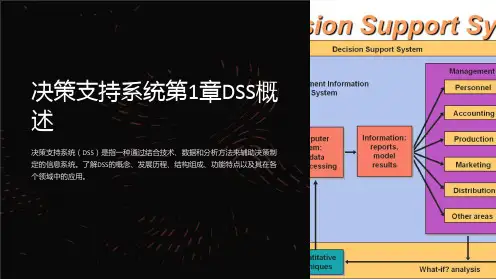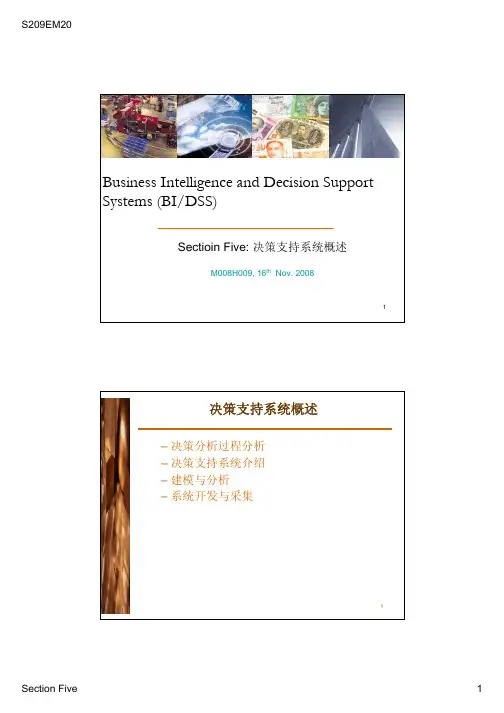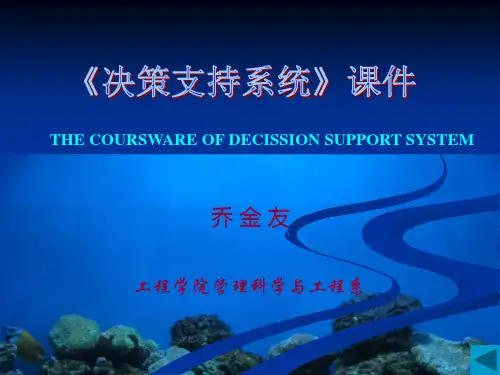决策支持系统概述.ppt
- 格式:ppt
- 大小:171.00 KB
- 文档页数:39

决策支持系统概述决策支持系统(DSS)是一种帮助管理者做出决策的信息系统。
它集成了数据收集、数据分析、模型构建和解决方案评估等技术工具,以提供定性和定量的决策支持。
DSS的目标是通过使管理者能够更好地评估和选择各种决策方案来提高决策质量和效率。
决策支持系统的基本构成包括数据仓库、模型和分析工具以及用户接口。
数据仓库用于存储和管理各种关键数据,包括历史数据、实时数据和外部数据等。
模型和分析工具提供了各种算法和方法,如统计分析、优化模型、模拟和决策树等,用于分析数据并生成决策结果。
用户接口是管理者与DSS交互的方式,可以是图形用户界面、自然语言处理或者其他形式。
1.数据分析:决策支持系统能够从数据仓库中提取数据,并通过各种分析工具对数据进行定性和定量的分析。
这些分析可以帮助管理者了解当前的业务情况和趋势,从而作出合适的决策。
2.模型构建:决策支持系统能够根据具体的问题和需求构建各种模型。
这些模型可以是统计模型、优化模型、模拟模型等,通过运行模型可以产生各种方案,并对不同方案进行评估。
3.解决方案评估:决策支持系统能够对各种决策方案进行评估和比较。
它可以根据不同的指标和权重对方案进行综合评估,并为管理者提供决策参考。
4.知识管理:决策支持系统可以帮助管理者收集和管理各种关键知识和信息。
它可以通过知识库、专家系统和数据挖掘等技术,将知识和经验转化为可用的决策支持。
5.沟通和协作:决策支持系统可以提供各种协作工具,帮助多个决策者之间进行沟通和协作。
这些工具可以包括电子邮件、在线会议和共享文档等,以促进团队决策的效率和准确性。
使用决策支持系统可以带来许多好处。
首先,它可以提高决策的质量和效率,通过提供准确和全面的信息,帮助管理者做出明智的决策。
其次,它可以降低决策的风险,通过模拟和评估不同的方案,管理者可以更好地估计每个方案的风险和回报。
最后,它可以提高组织的竞争力,通过加强决策者之间的沟通和协作,决策支持系统可以促进团队决策的效率和准确性,从而提高组织的整体竞争力。









Business Intelligence and Decision Support Systems (BI/DSS)Sectioin Five: 决策支持系统概述M008H009, 16th Nov. 20081决策支持系统概述–决策分析过程分析–决策支持系统介绍–建模与分析–系统开发与采集2Learning Objectives-1•Understand the conceptual foundation of decision making.•Learn Simon’s four phases of decision making.•Learn decision making flaws•Understand business decision support systems (DSS)•Learn characteristics and capabilities of DSS.•Understand DSS components and how they integrate.•Understand important DSS classifications.3Learning Objectives-2•Understand basic concepts of DSSmodelling.•Understand different model classes.•Know key issues of model management.•Discuss the major steps in developing a MSS•Describe the criteria used in selecting a MSS development approach •Understand MSS development principles45Decision Making-Definition •Process of choosing amongst alternative courses of action for the purpose of attaining a goal or goals.6Decision Making: Characteristics •Groupthink •Decision makers are interested in evaluating what-if scenarios •Experimentation with the real system may result in failure •Experimentation with the real system is possible only for one set of conditions at a time and can be disastrous •Changes in the decision making environment may occur continuously, leading to invalidating assumptions about the situation7Decision Making: Characteristics •Changes in the decision making environment may affect decision quality by imposing time pressure on the decision maker •Collecting information and analysing a problem takes time and can be expensive. It is difficult to determine when to stop and make a decision •There may not be sufficient information to make an intelligent decision •Information overload 8The Nature of Managers’Work [Make Decisions!] Mintzberg (1980) (Table 1.1) Roles •Interpersonal –Figurehead –Leader –Liaison •Informational –Monitor –Disseminator –Spokesperson •Decisional –Entrepreneur –Disturbance Handler –Resource Allocator –Negotiator Managers need information and use computers to support decision makingManagement •Management is–decision making•The manager is a–decision maker•Trial-and-error:–not a great approach•Decision making is becoming more difficult –More alternatives to choose from–Larger cost of making errors–More uncertainty regarding the future9Decision Type•Easy/hard decisions•Important/unimportant decisions •Routine/unique decisions •Personal/business decisions•Fun/troubling decisions….1011Decision TypeHighly Structured Highly Unstructured Semistructured Decisions •Emergent situation •Novel, unique •One-shot •Issues elusive •Knowledge hard to get •Creative •Established situation •Ordinary •Repetitive •Issues understood •Knowledge available •Programmable 12Decision Type •Programmed decisions –Complete, unambiguous solution procedure (algorithm) is available for making optimal decision.•Non-programmed decisions –For semi-& unstructured decisions, general solution strategies may be available, but optimal or correct decisions are not guaranteed –DSS were specifically designed to support non-programmed decisions13Decision Type•Unilateral decisions –Single person makes the decision, but may require knowledge from others •Negotiated/bargained decisions –Multiple participants must agree on decision –Negotiated decisions become more complex as the number of participants increases –Politics and power can play as much role as the decision itself 14Decision Style and Decision Makers •Decision style The manner in which a decision maker thinks and reacts to problems. It includes perceptions, cognitive responses, values, and beliefs –Heuristic –Analytic •Different decision styles require different types of support –Individual decision makers need access to data and to experts who can provide advice –Groups need collaboration tools –Autocratic –DemocraticManagers and Computerised Support •Information Technology:vital to the business•Support technologies extensively implemented•Computer application evolving from TPS and MIS to DSS•Early computerised information systems focused on efficiencyz Achieving goal with least required resourcesz Doing the thing right•Later computerised information systems focused on effectiveness.z Achieving the intended goalz Doing the right thing•You need both, but they are not interchangeable!15What Do Computerised Decision Support Offer?•Speedy computations•Improved communication•Increased productivity•Improved data management•Data warehouse access•Agility support•Quality support•Overcoming cognitive limits in processing andstorage•Using the web•Anywhere, anytime support1617The Concept of Decision Support Systems (DSS)•DSS are interactive computer-based systems, which help decision makers utilize data and models to solve unstructured problems (Scott Morton, 1971)•Decision support systems couple the intellectual resources of individuals with the capabilities of the computer to improve the quality of decisions. It is a computer-based support system for management decision makers who deal with semi-structured problems (Keen and Scott Morton, 1978). •DSS as an Umbrella term : Describes any computerised system that supports decision making in an organisation 18The Major Tools and Techniques of Managerial Decision Support •Data management •Reporting status tracking •Visualisation •Business analytics •Strategy and performance management •Communication and collaboration •Knowledge management •Intelligent systems •Enterprise systems Computerised Tools for Decision Support19Decision Making Process 20Decision-Making: The Intelligence Phase •Scan the environment •Analyse organisational goals •Collect data •Identify problem •Categorise problem –Programmed and non-programmed –Decomposed into smaller parts •Assess ownership and responsibility for problem resolution •Output: a formal problem statementDecision Making Process21Decision Making: The Design Phase •The design phase involves finding or developingand analysing possible courses of action–Understanding the problem–Testing solutions for feasibility–A model of the decision-making problem isconstructed, tested, and validated2223Decision Making Process 24Decision-Making: The Choice Phase •The CRITICAL act—decision made here!•Selection of most profitable, agreed-upon, most acceptable, least offensive alternative •Sensitivity analysis –A study of the effect of a change in one or more input variables on a proposed solution •Plan for implementation & monitoring25Decision Making Process 26Decision Making: The implementation Phase •Putting solution to work •Important issues to deal with:–Dealing with resistance to change –User training –Upper management supportDecision Making Flaws•Primary effects–Difficult to move away from the opiniondeveloped initially•Recency effects–Recently seen information•Availability bias–Most easily available information •Strategic anchoring–The initial assessment of the decision sets thetone for all that follows27Decision Making Flaws•Poor probability estimation–Overestimating the probability of positiveevents, underestimate the probability ofnegative events•Escalation phenomena–Difficult to abandon already adoptedcourses of action •Overconfidence•Groupthink28Improving Decision Making•Why is decision support needed?–Cognitive limits–Economic limits–Time limits–Competitive demands•Decision support methods–Providing access to tools and information–Enforcing rules and procedures–Automating decisions–Determining decision solution structures29 How Decisions are SupportedData Mining, OLAPESS ES SCMCRM ERP KMSANN30How Decisions Are Supported•Support for the intelligence phase–The ability to scan external and internalinformation sources for opportunities andproblems and to interpret what the scanningdiscovers•Web tools and sources are extremely useful forenvironmental scanning•Web browsers provide useful front ends for a variety oftools (OLAP, data mining, data warehouses)•Internal data sources may be accessible via a corporateintranet•External sources are many and varied31How Decisions Are Supported•Support for the design phase–The generation of alternatives for complex problems requires expertise that can beprovided only by a human, brainstormingsoftware, or an ES32How Decisions Are Supported•Support for the choice phase–DSS can support the choice phase through what-if and goal-seeking analyses–Different scenarios can be tested for the selected option to reinforce the final decision–KMS helps identify similar past experiences–CRM, ERP, and SCM systems are used to test the impacts of decisions in establishing their value, leading to anintelligent choice–An ES can be used to assess the desirability of certain solutions and to recommend an appropriate solution – A GSS can provide support to lead to consensus in a group33How Decisions Are Supported•Support for the implementation phase –DSS can be used in implementationactivities such as decision communication, explanation, and justification–DSS benefits are partially due to thevividness and detail of analyses andreports34DSS Description•DSS applicationA DSS program built for a specific purpose (e.g.,a scheduling system for a specific company)• A DSS supports all phases of decision making and may include a knowledgecomponent• A DSS can be used by a single user on a PC or can be Web-based for use bymany people at several locations35 DSS Description36Components of DSS37Components of DSS•Data management subsystem•Managed by DBMS•Model management subsystem•Managed by MBMS•User interface subsystem •Knowledge Management and organisational knowledge base subsystem3839Data Management Subsystem •Components:–DSS Database•Decision maker’s personal database•Database specifically built for DSS•Data gathered from, or access provided to otherorganisational or external database–Database management system•Software system which provides (and sometimesprohibits) access to database contents–Data directory•Index of all data items contained in a database –Query facility40The Model Management Subsystem41Model Management Subsystem•Components:–Model base–Model base management system–Model directory–Model execution, integration, andcommand processor42Model Base•Strategic–Supports top management decisions •Tactical–Used primarily by middle managementto allocate resources•Operational–Supports daily activities•Analytical–Used to perform analysis of data43Model Base Management System•Functions:–Model creation–Model updates–Model data manipulation–Generation of new routines•Model directory:–Catalog of models–Definitions44Model Management Activities •Model execution–Controls running of model•Model command processor–Receives model instructions from userinterface–Routes instructions to MBMS or moduleexecution or integration functions •Model integration–Combines several models’operations45 Components of DSS4647User Interface (Dialog) Subsystem 48Knowledge-Based Management System •Expert or intelligent agent system component •Complex problem solving •Enhances operations of other componentsDSS Classification•The AIS SIGDSS classification–Communications-driven and group DSS•Support group meetings, collaborative tools–Data-driven DSS•OLAP, data mining–Document-driven DSS•KMS (text based)–Knowledge-driven DSS, data mining, and management ES applications•Intelligence-based systems–Model-driven DSS•Any system with various models (mathematical model,statistical packages, financial models etc)–Compound DSS49DSS Classifications•GSS v. Individual DSS–Decisions made by entire group or bylone decision maker•Custom made vs. vendor ready made –Generic DSS may be modified for use •Database, models, interface, support arebuilt in•Addresses repeatable industry problems•Reduces costs50Modelling51 DuPont Simulates Rail TransportationSystem and Avoids Costly Capital Expense •Case presentation52DuPont Simulates Rail Transportation System and Avoids Costly Capital Expense •Promodel simulation created representing entire transport system •Applied what-if analyses•Visual simulation•Identified varying conditions •Identified bottlenecks•Allowed for downsized fleet without downsizing deliveries53Models & Modelling•What is a model?–A replica of a real system or object–An abstraction of reality•Model format–Iconic model–Analog model–Mental model–Mathematical model54Models and Modelling•Why do we need models?–Easier manipulation–Compression of time–Lower cost–Risk analysis–Analysis of a very large number of possiblesolutions–Enhance and reinforce learning and training–Available on the Web55DSS Modeling•Key element in DSS•Many classes of models•Specialised techniques for each model•Allows for rapid examination of alternative solutions•Multiple models often included in a DSS •Current trends–Model libraries and solution technique libraries–Development and use of Web tools–Multidimensional analysis (modeling)• A modeling method that involves data analysis in severaldimensions56DSS Models•Algorithm-based models•Statistics-based models•Linear programming models •Graphical models•Quantitative models•Qualitative models•Simulation models57Models and Modelling•3 conditions under which models operate:–Certainty–Risk–Uncertainty5859Certainty, Uncertainty, and Risk •Certainty A condition under which it is assumed that future values are known for sure and only one result is associated with an action •Risk A probabilistic or stochastic decision situation •Risk analysis – A decision-making method that analyses the risk (based on assumed known probabilities) associated with different alternatives. Also known as calculated risk –Calculate value of each alternative –Select best expected value 60Certainty, Uncertainty, and Risk •Uncertainty –Several outcomes for each decision –Probability of occurrence of each outcome unknown –Insufficient information –Assess risk and willingness to take itStatic Models•Single photograph of situation •Single interval•Time can be rolled forward, a photo at a time•Usually repeatable•Steady state61Dynamic Model•Represent changing situations •Time dependent•Varying conditions•Generate and use trends •Occurrence may not repeat62Modelling & Decision Making Strategies •Normative Model–Describe what we should do–Optimisation–Economic optimisation–Utility optimisation•Descriptive Models–Describe what we do–No guarantee for optimal•Satisficing–“good enough”solution63Modelling Steps•Define & analyse the problem•Select and/or construct the model–Variables: controllable–Parameters/constraints: uncontrollable, limitson possible solutions–Objectives: singular or multiple•The model establishes relationships among variables, parameters, objectives, and constraints6465Modelling Steps•Validate the model: does the model accurately represent the real system?–Compare model output with historical or real-world data –Have model evaluated by experts –Have model evaluated by decision makers –Compare model output with expectations based on experience & expertise •Acquire input data –Input data must be accurate & timely –Use data to design modelling experiments •Solve the mode/develop the solution •Test the model solution –Is it realistic? Is it valid?•Sensitivity analysis of modelling results •Implementation of modelling results 66Modeling with Spreadsheets •Flexible and easy to use •End-user modeling tool •Allows linear programming and regression analysis •Features what-if analysis, data management, macros •Seamless and transparent •Incorporates both static and dynamic modelsModelling & Computers•Why use computers for modelling?–Execution speed–Model size–Model complexity–Support for model development–Support for model management•Model base management system (MBMS)–Software for establishing, updating, combining, and so on(e.g., managing) a DSS model base67 DSS Development6869The Landscape and Framework of DSS Application Development 70The Landscape and Framework of MSS Application Development •Step 1: –Planning, identifying, and justifying MSS •Step 2: –Creating a MSS architecture –MSS architecture A plan for organizing the underlying infrastructure and applications of the MSS project71The Landscape and Framework of MSS Application Development •Step 3: Selecting a development option –Build the system in house –Have a vendor build a custom-made system –Buy an existing application and install it, with or without modifications, by yourself or through a vendor –Lease standard software from an ASP, utility computing, or set up a software-as-a-service arrangement –Enter into a partnership or an alliance that will enable the company to use someone else's application –Use a combination of these approaches 72Development Options for MSS Applications •In-house development: Insourcing –Building from scratch –Building from components –Integrating applications •Outsourcing •Buying applications •Leasing applications –Lease from an outsourcer and then install it on the company’s premises –Lease from an ASP that hosts the application at its data center –Software-as-a-service •Partnership •Hybrid models work best when the outsourced partner offers:– A high level of security –Fast time to market –Service-level agreements73The Landscape and Framework of DSS Application Development 74The Landscape and Framework of MSS Application Development •Step 4: –Installing, testing, connecting, and deploying MSS applications •Step 5: –Operations, maintenance, and updatingThe Landscape and Frameworkof MSS Application Development•Managing the development process –The development process can be fairlycomplex and must be managed properly–For medium to large applications, aproject team is usually created to managethe process and the vendors•Project management software75Top 10 Reasons for Project Success •Executive support•End-user involvement•Experienced project manager•Clear business objectives•Minimised scope•Standard infrastructure•Firm basic requirements (knows where you are going)•Formal methodology•Reliable estimates•Skilled staff76DSS Development Principles•What DSS developers should know:–DSS development requires a substantialinvestment of money and effort–DSS use has the potential to substantiallyimpact organisational decision making–So, there are no unimportant or small DSS–Therefore, DSS development should beperformed carefully and thoughtfully.77DSS Development Principles•Good DSS development:–Use a standard methodology.–Use proven tools and techniques.–Document the design and any changes.•In short, DSS development mirrors Information Systems Development78Summary•Decision Making Process •Decision Making Flaws•Decision Support Systems •Modelling•DSS design79Next Section’s Topic•群体决策支持系统–Group Four case presentation–GDSS介绍–软件演示(Group Five)80。
